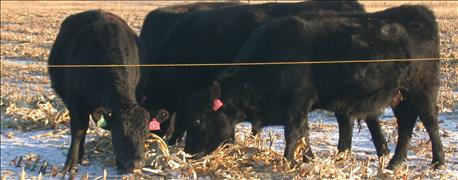February 29, 2016

From 75-90% of a beef calf's fetal growth occurs during the last three months of pregnancy and the cow's nutrient needs change dramatically.
To make sure you are on track with what and how much you are feeding pregnant beef cows this time of the year, Carl Dahlen, North Dakota State University Extension Service beef cattle specialist, says to take these three steps:

Cows forage for food in the snow. Their nutriental needs will increase dramatically in the three months before they calve.
1) Evaluate. Have a good look at your anticipated calving dates, cow body condition scores and the diet the cows are receiving,” he advises. “Current protein and energy content of native pastures and/or crop residues likely are not suitable for cows calving in early to midspring. Supplement cattle accordingly, and remember the increased plane of nutrient needs the cows are experiencing.”
As mature cows move from mid to late gestation, they need a 20 percent increase in crude protein intake and 16 percent increase in total digestible nutrient intake to keep up with increasing fetal growth. This need for additional nutrients is magnified once a cow calves and must produce milk for a calf.
Although some producers argue that providing fewer nutrients during gestation will lead to lighter birthweights and, therefore, fewer calving difficulties, that isn’t always the result, according to Dahlen.
“Unfortunately, the smaller calves were the only potential benefit of the low feeding level in several studies,” he says. “Cows fed the high level of nutrition actually had less calving difficulty, even with slightly bigger calves.
“In addition, while calf survival at birth was similar between the groups, calf survival at weaning was much greater in cows fed the high levels of nutrition,” he adds. “Calves from dams fed the low levels of nutrition had more issues with scours and scours-related mortality, compared with calves from dams fed high levels of nutrition.”
A separate study found that cows with inadequate body condition produced poorer-quality colostrum, compared with cows in good body condition. Poor body condition resulted in a reduced ability to transfer immunity through colostrum to calves of underfed cows. Newborn calves need adequate colostrum because it contains antibodies and other proteins that protect calves from disease until their own immune system is totally functional.
Studies also show that the need for good nutrition during pregnancy carries over to fertility the following breeding season. Cows that are thin at calving have a greater chance of not becoming pregnant the following breeding season, compared with cows that calve in good body condition. Therefore, thin cows and heifers need to be on a greater plane of nutrition than older cows in good condition.
2) Sort. Dahlen recommends producers consider sorting heifers and thin cows into their own group for feeding if possible. If not, producers should try to spread feed out over a larger area to reduce the incidence of thin cows being pushed away from feed by older cows or cows in better condition. If facilities are available to feed different groups of cows, heifers and thin cows should be fed separately from mature cows.
3) Adjust. Keep temperature in mind and protect cattle from wind and moisture to the extent possible. Even with heavy winter coats, nutrient requirements for cows begin to increase when the temperature is below the “lower critical temperature” of about 18 F. That lower critical temperature is much greater if cattle are wet or exposed to the wind.
For every degree below that lower critical temperature, energy requirements can increase by 1 to 2 percentage units of total digestible nutrients (TDN). This means the same 1,300-pound cow that needed 12.5 pounds of TDN per day at a temperature of 18 degrees F may need up to 14.8 pounds of TDN per day at a temperature of 0 F. However, cows have a limit on how much they can eat, so producers may have to increase the quality of the feed in addition to the quantity to ensure cows are meeting their requirements.
“Evaluating the nutritional status of cows now and taking appropriate action will allow you to provide appropriate nutrients to get cows into good body condition at calving while encouraging the fetus to do exactly what it needs to do: grow, baby, grow!” Dahlen says.
Source: NDSU Extension Communications
You May Also Like




